Drying is a traditional fiddlehead recipe you need to try. I love fiddleheads. But, the season for them seems to go lightning fast: one minute they're everywhere, the next minute they're unraveled.
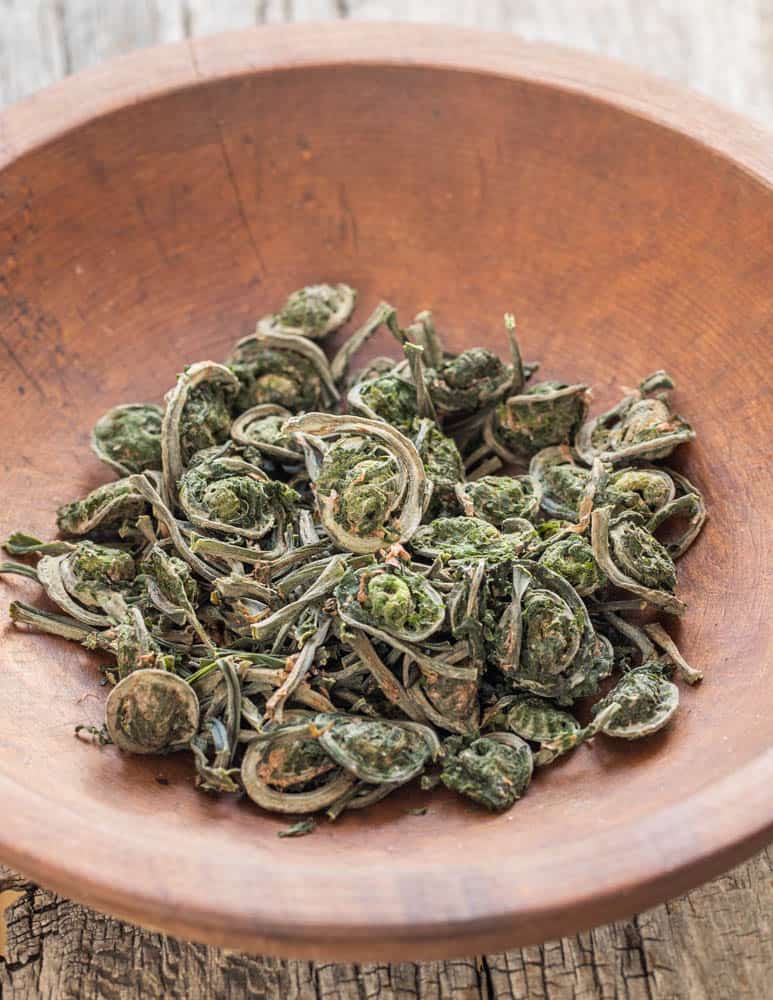
I've preserved them (crunchy pickled fiddleheads) and that works well. What you might not know is that you can dehydrate fiddleheads as they do in Japanese and Korean culinary traditions.
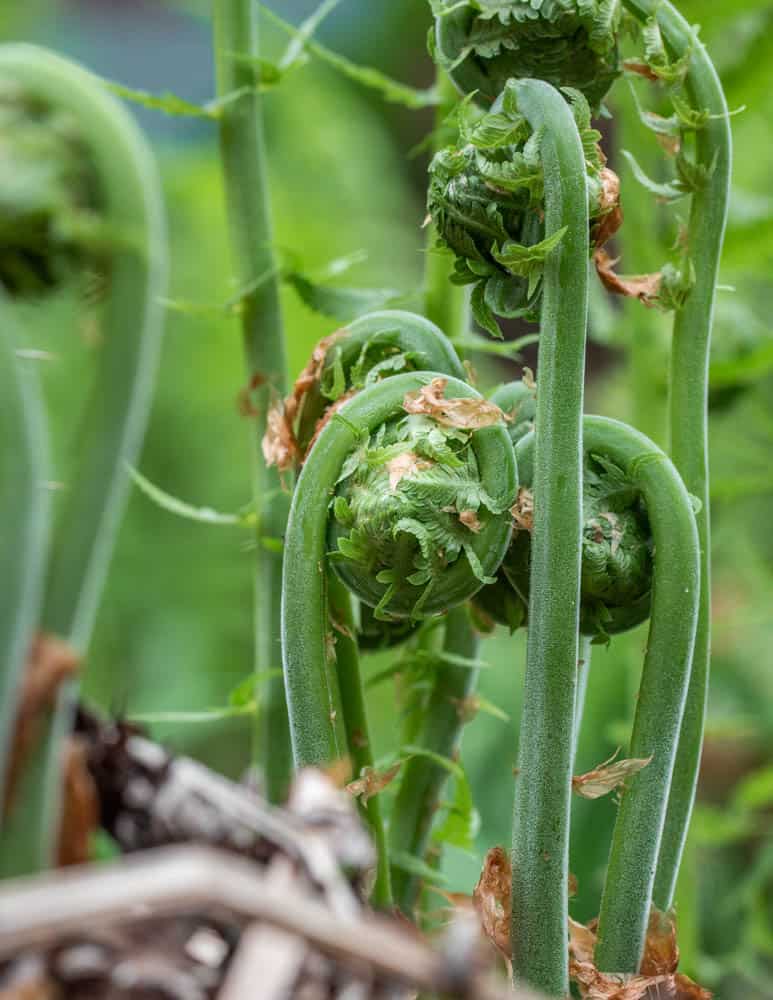
I can't take credit for the method, that goes to my friend Linda Black Elk who shared it with me.
When she and her husband Ahán Heȟáka Sápa came out for my plant walk with Sam Thayer last year in the Spring, one thing she mentioned I should try was dehydrating my fiddleheads.
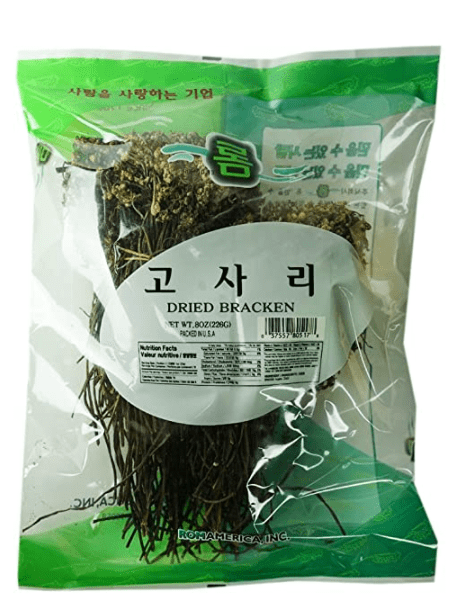
If you go to an Asian market and head over to the dried section you'll see bags of black twigs with the name "fernbraken" on the front.
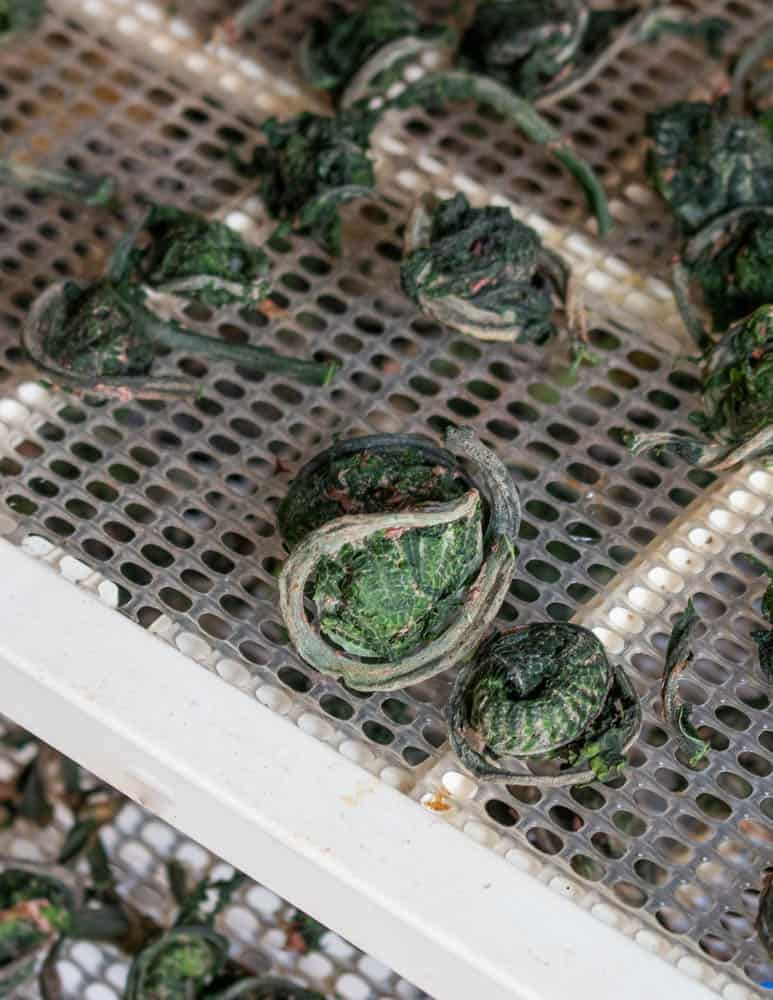
The fernbracken, as the name implies, are ferns. They aren't the ostrich ferns that I pick in Wisconsin, or lady ferns from the Pacific Northwest, but they're close.
Fernbraken (also known as gosari or fernbrake), are bracken ferns (Pteridium aquilinum) and are a calling card for certain dishes in Korean cuisine that may specifically call for them dried.
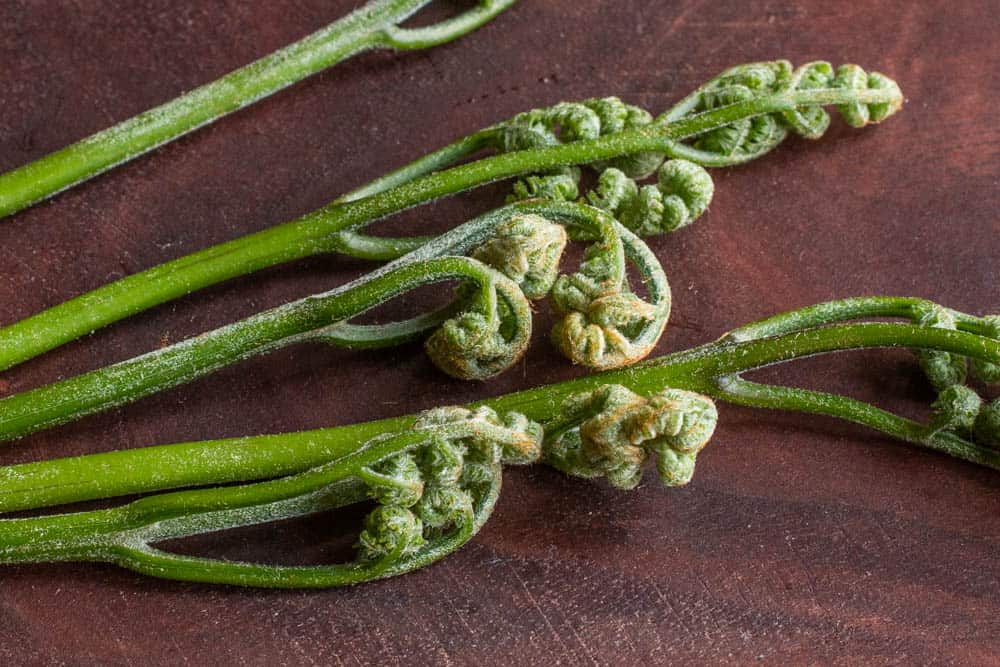
Bibimbap, the well known dish of rice with mixed vegetables and condiments (cursory description here) is probably the most famous dish I've heard of using gosari, and, after digging into my first jar of dried fiddleheads this winter, I knew why. They're a sort of tasty fern concentrate.
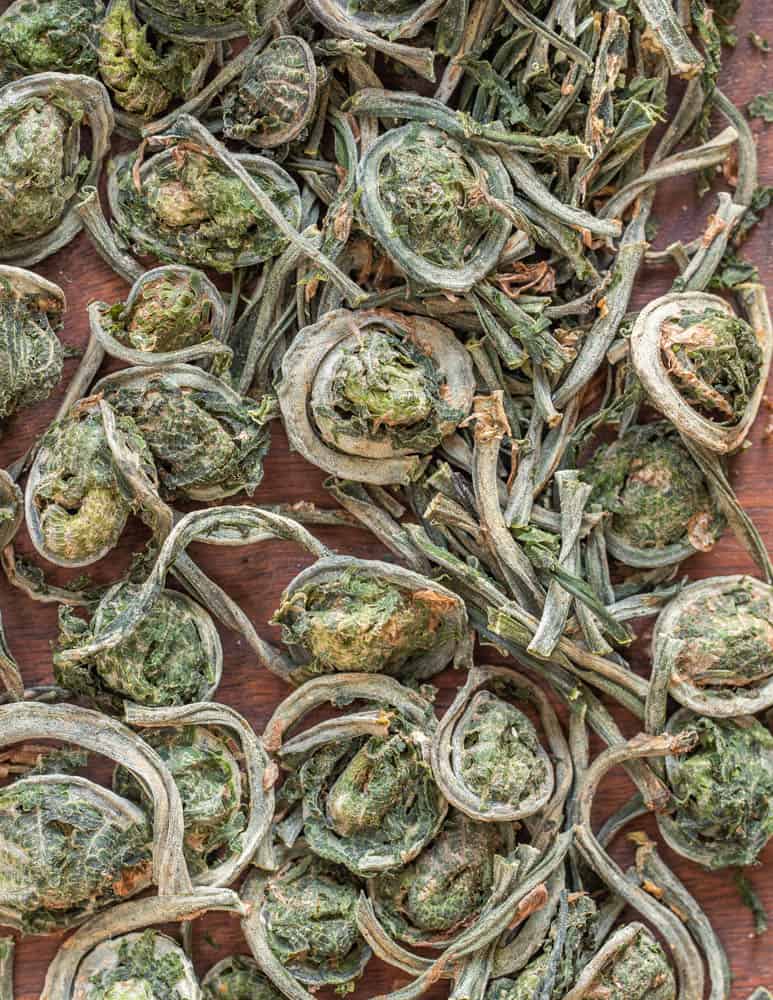
What do Gosari Taste Like?
Dried gosari fiddleheads are concentrated. Fiddleheads have a mild flavor fresh, but the flavor is intensified by drying.
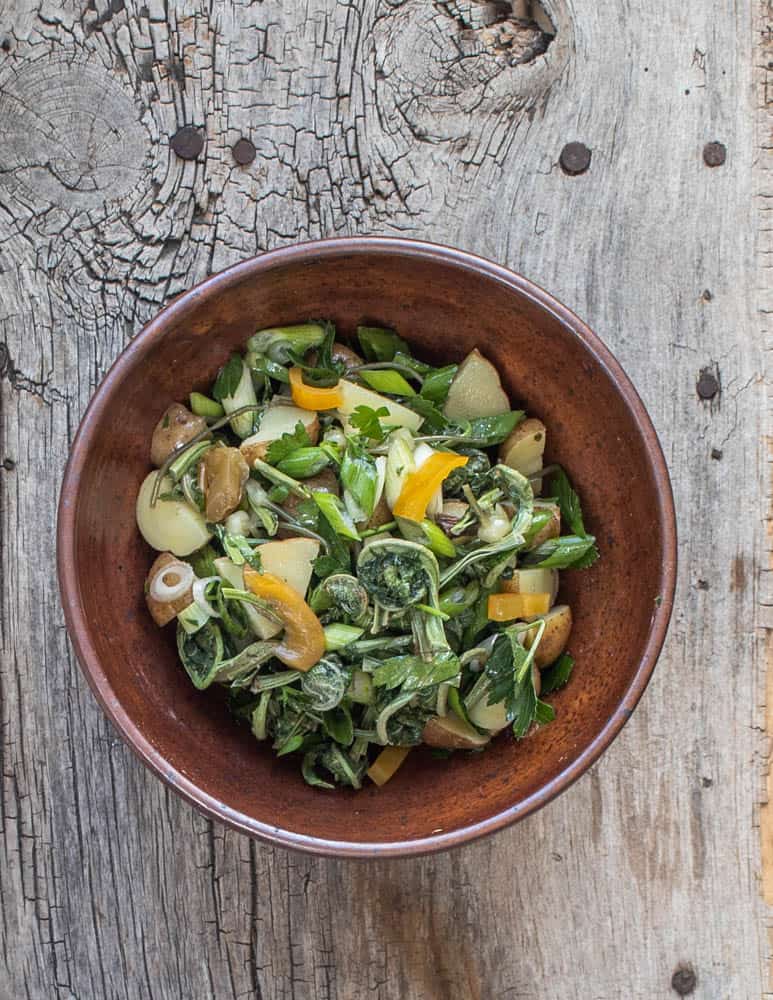
The flavor of dried fiddleheads was stronger than I expected, and reminded me of the oceanic, saline quality I taste when I puree or cook large amounts of common stinging nettles. It's definitely a verdant, umami taste.
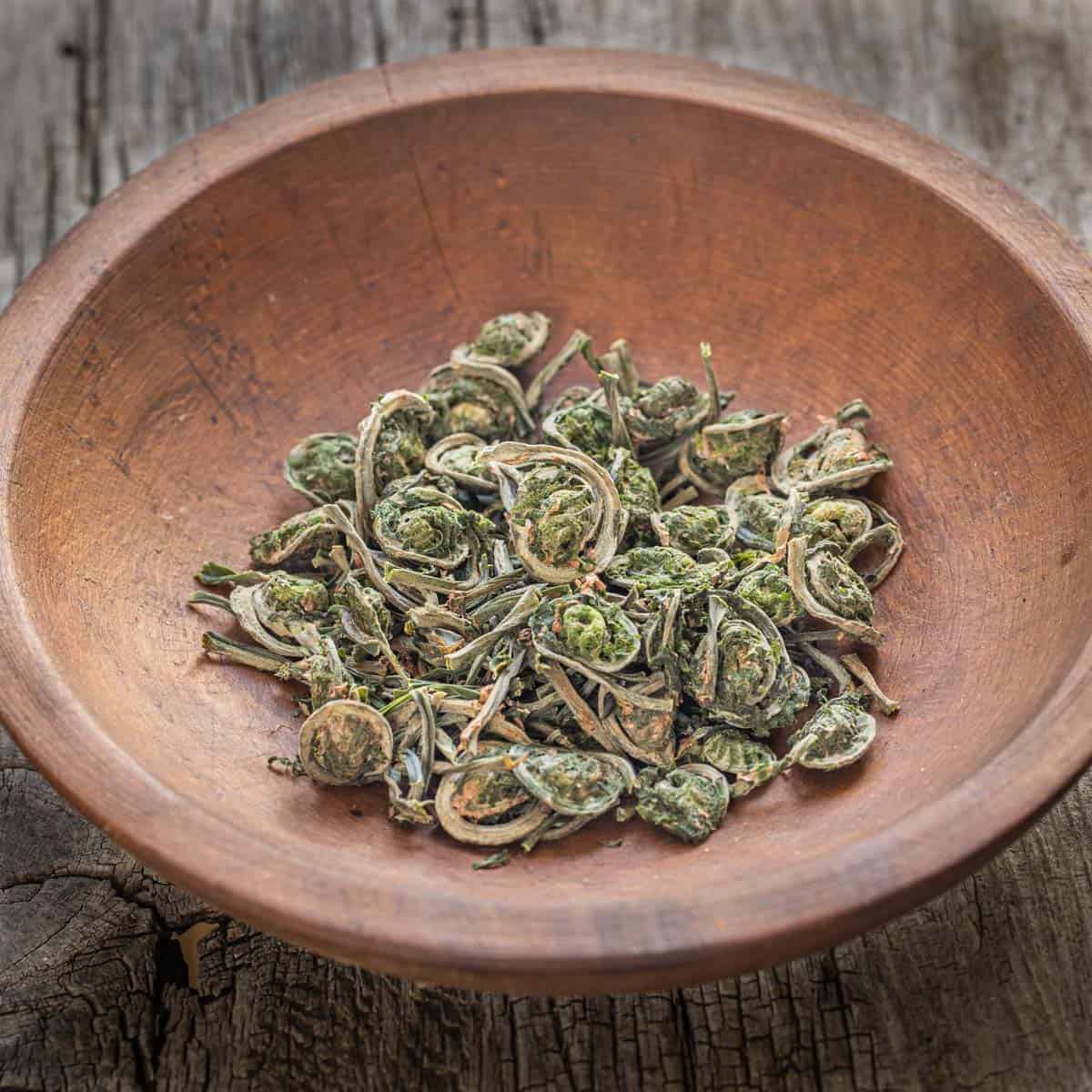
If you have a fern patch like me, and you end up having bags of them in the fridge, consider taking a bag and drying them to try them out, if for no other reason than to make your own version of Bibimbap, or adding them to a noodle soup.
Cooking
Use those stems
The whole fiddlehead, including the stems are edible, and shouldn't be discarded. Drying the stems is a good way to preserve them and save space, it's genius, really. After rehydrating, they'd be good added to sauteed asparagus and mushrooms with fiddleheads.
Adding to soups
It won't do to just chuck the ferns in a random pot of soup or something like that. The ferns hydrate as they cook, and, as they're coiled to begin with, they'll unravel.
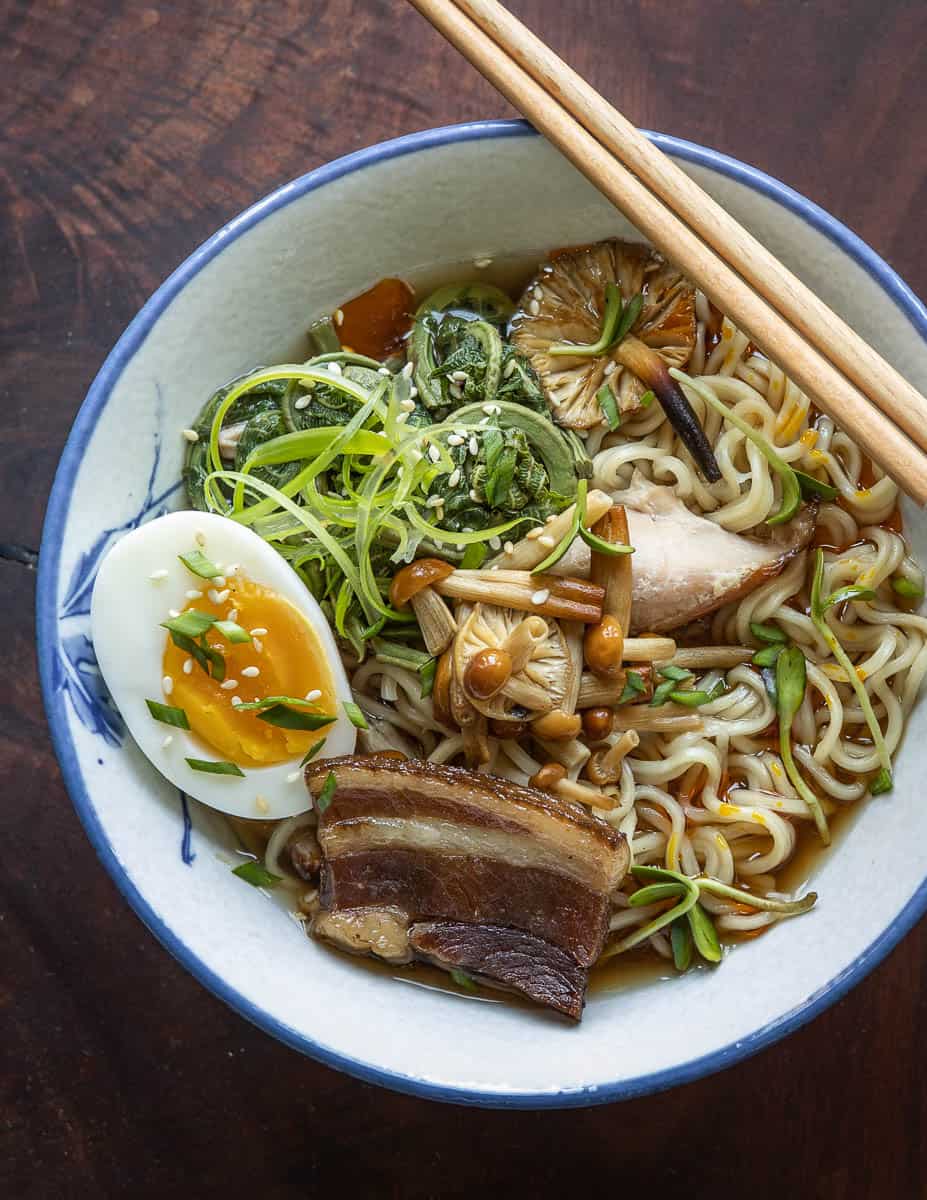
So, for example, if you want to add them to soup, soak them, then chop and add at the end of cooking to avoid green fern worms on your spoon. Stick to clean, minimalist flavors, things like miso soup, simple broth with vegetables, etc.
Salads
My favorite thing to do with them so far has just been to either soak them until hydrated and still a bit chewy, an hour or two, or gently cook them in water until just tender.
From there, I toss them with some oil and other chunky ingredients and fashion a salad out of it. This is the probably my favorite way I've found to enjoy their flavor.
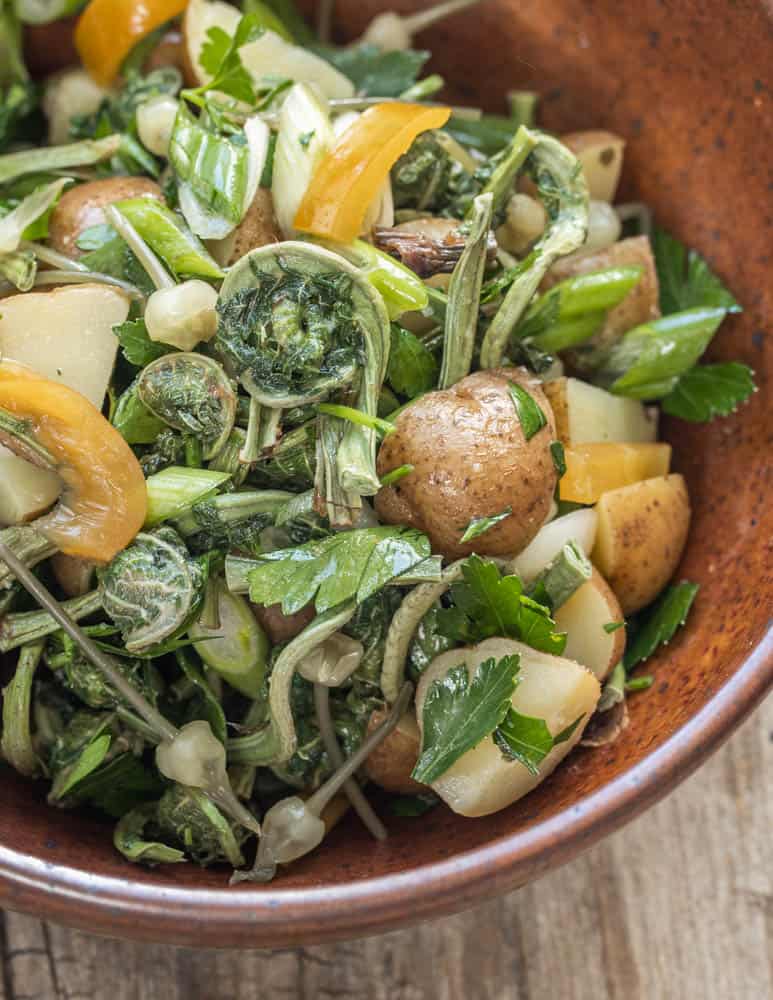
Below is a variation on German potato salad (no mayo!) you could adapt, but something as simple as a few sliced cold potatoes with good oil and something sharp to wake it up (fermented ramp seeds and onion bulbils here with a few pickled peppers) would be good too. I'm sure you can find plenty of things to do with them.
More Fiddleheads
Dried Fiddlehead Ferns (Gosari)
Equipment
- 1 Dehydrator
- 1 pot for blanching
Ingredients
- 2 lb or more fresh fiddlehead ferns including long lengths of stem if available
- 1 gallon water
- Kosher salt to taste
Instructions
- Brush off as much of the brown paper covering from the ferns as you can, if any.
- Cut the stems of the fiddleheads into 1 inch lengths, keeping the coiled croziers whole.
- Bring a pot of lightly salted water to a boil, then blanch the ferns and cook for 60 seconds.
- Turn off the heat and quickly remove the ferns with a slotted spoon or Chinese spyder strainer (get one if you don’t have one) and allow to cool naturally and drain, spread out (you can use the dehydrator trays) for a few minutes, patting them dry to remove excess water.
- Dehydrate the fiddleheads on high (145-150 F-ish) for 24-48 hours or until completely bone dry, then store in an air tight container like a mason jar in a cool dry place. They’ll last until next season and beyond, just make sure they’re completely bone dry before storing.
- To rehydrate and cook the ferns, soak them for a few hours until soft and chewy in cold water, or cook in water to cover in a pot until they're tender and taste good to you, then drain and add to whatever recipe you’re making.
Notes
Nutrition
Salad of Potatoes, Dried Fiddleheads and Sour Onions
Ingredients
- ½ cup dehydrated fiddleheads
- 5 oz small potatoes such as German butterballs
- Kosher salt to taste
- Small handful pickled hot peppers such as banana peppers, cut into ½ inch pieces
- 2 tablespoons chopped fresh parsley or another mild herb like celery leaf coarsely chopped
- 1 tablespoon fermented onion bulbils ramps seeds (optional)
- 2 scallions tender white and green parts only, sliced ¼ inch
- 1 tablespoon Hickory nut oil or another rich tasting salad oil like extra virgin, to taste
- Splash of maple vinegar or apple cider vinegar
Instructions
- Cover the potatoes with water and a generous pinch of salt, bring to a simmer and cook until just barely tender, then drain and cool.
- For the strongest flavored fiddleheads, soak them in cold water to cover for a few hours until tender, but still a little chewy (just make sure they taste good to you). To rehydrate them quickly and have them be more tender, simmer them for 10 minutes or so until water to cover until just tender, then drain and cool.
- To serve, toss the potatoes with the remaining ingredients, mix well, taste and adjust the seasoning for salt, acid and spiciness, and serve. If you want to make it ahead of time, omit the vinegar until just before serving.

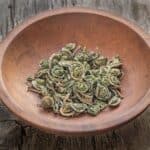
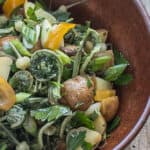
Cei
I would really like to try this with some of the ferns I picked this year! (I'm in Canada, so late season XD)
I'm curious through- since I've always heard you must boil or steam these thoroughly, is there something about this process that also makes them safe to eat?
Alan Bergo
Cei, it's completely, utterly safe. Bracken ferns are sold around the world commercially-thousands of pounds a year. Those ferns are dried with no cooking beforehand. Here I use ostrich ferns, which don't require any special preparation other than cooking, and I blanch them beforehand, mostly to keep their green color. Dehydration is also a form of cooking.
Cei
That's so great to know, thanks!! I've never thought of drying as a type of cooking, but given its basically as transformative as adding heat, it makes sense!
Doreen
Picking for the first time. My question is what to do with the fern leaves that are on the stem, some as long as an inch-- cut them off? eat them?
Alan Bergo
Sounds like your ferns are past prime for picking and too mature. The leaves shouldn’t be that long.
Autumn
I know the climate varies from northern Minnesota and Wisconsin to the Southern parts of the state and harvesting times can vary along with it.I also know that you are usually writing and posting about things that are seasonal but I wonder have you ever made or thought of making a chart for what time of year we should start foraging for the different wild edibles?
Annika Robertson
Hi... I have heard that fiddle heads are cancerogenic and the reason for the high prevalence of stomach cancers in Japan. How true is that and if it's true, should these be recommended for eating? I would love to eat 'em because where I live, bracken is invasive on disturbed farm land even if they are native.
Alan Bergo
This is a little beyond the scope of this post, but I opened up the can of worms so I'll tell you my opinion.
Bracken ferns are a traditional food, and they've been eaten for a very long time. This is a complicated issue, but I think it's important to take into account that the populations often referenced in studies may eat much larger quantities of bracken fern. There's lots of things to mention. Another thing I personally believe is that we have "new" studies and things that come out all the time saying what's cancerous. People can argue that cinnamon, nutmeg, and bacon are cancer-causing foods, too, with the right dosage. Instead of just throwing foods out the door when society proclaims a new "bad food", especially if that food is a traditionally harvested and consumed plant dating back longer than western science has been around, I really think it's important to balance the new studies with the ethnobotanical evidence.
I think it's fine to eat small amounts of bracken fern seasonally, especially if the taste good to you and you blanch them for longer than other ferns. More importantly in my mind, is there's also no place that I can find that discusses if commercial, dried gosari are blanched before drying. As this is a dried product, a larger serving by weight can happen sometimes since the product has no water weight, which can result in a higher amount of problem compounds per serving. Since fiddleheads do not retain their bright color after drying if they aren't blanched, and the commercial gosari are very dark and not green, I suspect they're dried fresh. I think it's likely that blanching the ferns will remove a lot of anything you wouldn't want, just like say, when boiling things like Gyromitra mushrooms. Boiling things in water to sterilize or denature them in some way is a human constant around the world.
My friend Hank's article on bracken might be helpful to read too.
https://honest-food.net/bracken-fern-edible/
Louise
Eugeina Bone waxed poetic about you in a myco talk today! I will check my many Ostirich Ferns to see if I can find any fiddleheads tomorrow, Thanks.
Alan Bergo
Thanks Louise. Yes, Eugenia and I spoke for an entry in the book she's writing last summer. I've so enjoyed her work over the years.
Keith Langdon
Thanks Chef! I will be dehydrating fiddleheads this year. I have tried pickling- meh and freezing - mushy meh.
Alan Bergo
I know, people like to pickle things so I have a few versions here, but you can only eat so many pickles. If you overcook the dried ones obviously they'll get soft, but left with a tiny bit of chew I think they're pretty cool. Enjoy.
Ben Rosen
You had me at Fiddle head fern .